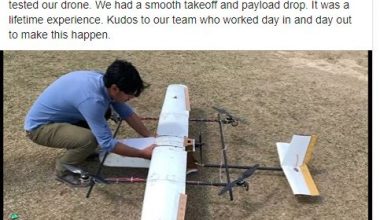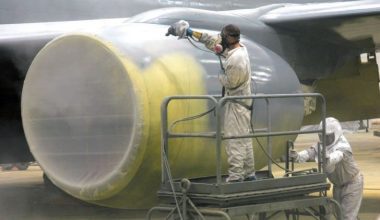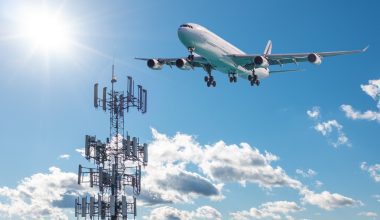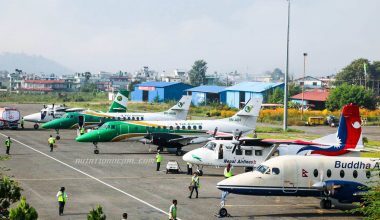Aircraft often have brightly colored livery and designs on the outside that represent the carrier they are operating for. The aircraft painting is essential for various reasons, including protection of the vessels from the elements and corrosion to the aircraft’s identity, their company, or organization.
But, the industry requirement for the aircraft paintings is not as simple as a home or vehicle decoration; the aircraft paints are expected to stand the test of time besides carrying the attractive designs and livery.
Read More: Boeing Logo and Airbus Logo vivid history

Painting Process of Aircraft Painting
The planes are normally painted at the time period of 7 to 10 years; before applying the new paints, the aircraft have to be tripped off the old paint completely.
In general, the paints are applied in three layers: primer, base coat, and topcoat; the topcoat layer gives the aircraft their shiny looks. After the old color is stripped off, the primer layer is applied on the aircraft adding base coat next, and finished the final touches with the shiny top coating.
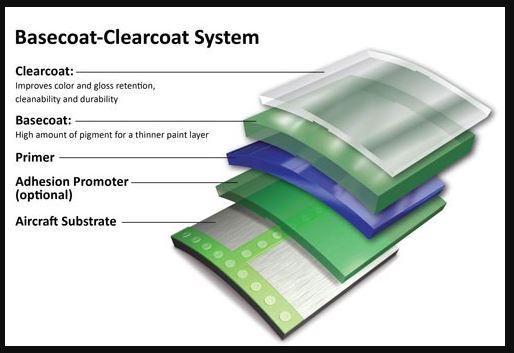
The air vessels are towed to the dedicated painting hangar, completing all the necessary inspections in the first step. The inspection process is carried out to determine the state of the aircraft before painting to list the possible, probable challenges during the painting process. Then, the aircraft are docked and masked for sanding the old paint; several paint strippers are applied to the aircraft’s surface, completely removing the old paint.
After completing the sanding process, the aircraft are washed with clean cold water, re-masked for the primers, and gradually applied to other paints layers. The majority of the aircraft are painted with a high volume and low-pressure spraying system. The low-pressure painting system can add a very thin, even layer of paint to the surface of the aircraft. The latter process requires a lot of re-washing, masking, sanding and even manual abrading to reach the final clear-coating stage. The aircraft are also weighed after the finishing touches if deemed necessary.
It can take few days or a few weeks to entirely paint the aircraft depending on their size and the number of layers required depending on the type of paint.
Types of paint
Typically there are two main types of paints that are used on aircraft painting.
Epoxy
Epoxy is a polyurethane paint that adheres pretty well to the surface of the aircraft. It is formed by the reaction of a hardener and a resin. These paints are known for high heat and good electrical insulation, making them perfect for high-altitude flights.

The epoxy paints don’t dry as hard as enamel, so it doesn’t chip or breaks out easily over time. The epoxy paints also have high chemical resistance quality that doesn’t fade, oxidize, or brittles easily with durable and exceptional bond strength.
Enamel
The enamel painting is the low-cost option to paint the aircraft; this painting method is also not as dangerous as the epoxy paint, which expels certain gases during the painting process and is extremely dangerous in exposure cases. The aviation industry enamel is very different from commercial enamel; the enamel paint used in the aircraft are extremely hard and resistant to chemicals and several conditions. The toughness of enamel makes it possible for the aircraft to handle the harsh circumstances and weather conditions that it is regularly exposed to.

Two of these paints can also be used together; often, enamel paint is used for the plane’s design and color, whereas epoxy is applied for extra strength and shine. When applied together, epoxy and enamel form a perfect concoction of artistry and strength.
Why Are Airplanes Painted White?
Most travelers, even the frequent fliers, have always wondered about the white base color of the aircraft but never bother to ask why the planes are painted white. Each of the carriers has its own unique branding or livery; underneath the graphic, nearly all the passenger carriers are sport white.
But the aircraft weren’t painted white initially; it was rare to see the airplane painted white in the dawn of the aviation industry. Manufacturers and airlines preferred the aircraft with bare metal or chrome, with a little paint or no paint at all.

As the aviation industry started to grow, the carriers and builders eventually turned away from the bare metal and no paint strategy as it caused quick stains of dirt and stains on the aircraft’s exterior. It increased the workload for the airlines to clean up the aircraft frequently in order to not leave a bad impression on the passengers. So, the aircraft started to receive paintings for a complete finish, which also extended the aircraft’s longevity.
Although it is not a mandatory rule most of the airlines have white color uniformity due to the reasons like:
1. White color reflects sunlight
One of the major reasons the airplanes are painted white is due to their quality of reflecting the sunlight. Other darker shades will absorb most of the sunlight, which is not good because it will heat up the body of the airplane that can be prone to system failure and many other obstacles, so the sunlight reflecting the quality of the white paint makes a comfortable air-traveling experience possible even when flying so close to the sun.
It also minimizes the cabin heating of the aircraft when they are parked on the ground covering the potential damage from the solar radiation both on and off-air.
2. Less fading quality
When flying, the aircraft are exposed the various intense atmospheric conditions; they are also constantly muddling through the extreme weather conditions. With the exposure to various weather conditions and different elements present in the atmosphere, the aircraft fades, other colors besides white fades even faster. The white color painting doesn’t fade as faster as other shades even after spending a significant amount of time battling several conditions.

So, if it is necessary to repaint the aircraft within a short span repeatedly, it can be quite costly for the carriers because the paintings are not just expensive; they also add significant weight to the aircraft up to 550kg additional weight which will burn more fuel resulting in the failure of the essential cost optimization. Not only that, the repainting procedure takes about one to two weeks, grounding the aircraft for such a long period affects the revenue generation.
3. Easy damage detection
Unlike the darker shades, which can perfectly blend in damages to some extent, the white-painted aircraft can be easily inspected for the damage on their regular checkups, usually done before each flight by ramp engineers and even pilots. Aircraft require regular checkups for safety reasons; the inspection officers look out for any kind of damage or wear on the aircraft routinely.

If the aircraft are painted white, it makes the inspection easier, the inspecting officers can detect bumps, cracks, oil spills, and other faults quite easily on the white surface compared to other darker shades. This allows the airlines to perform necessary repairments and maintenance swiftly, ensuring the safety and comfort of the travelers all the way in.
4. Reduces the possibility of birdstrikes
Birdstrikes are a pretty common issue faced by aircraft; the gigantic size of the aircraft puts it at risk of birdstrike when it is in-flight, taking off, landing, or at a low altitude. Generally, it is quite common, but it can be a significant threat to smaller-sized aircraft. The birdstrike can possibly strike structural damages to the aircraft like penetration of flight deck windscreen or significant damage to the control surface or the empennage, which can have a hazardous effect on the stability and safety of the carrier. Likely on the bigger aircraft, especially jet-engine aircraft, are vulnerable to the loss of thrust following the ingestion of birds into the engine’s intakes which can cause an error in the dependent instrument readings.
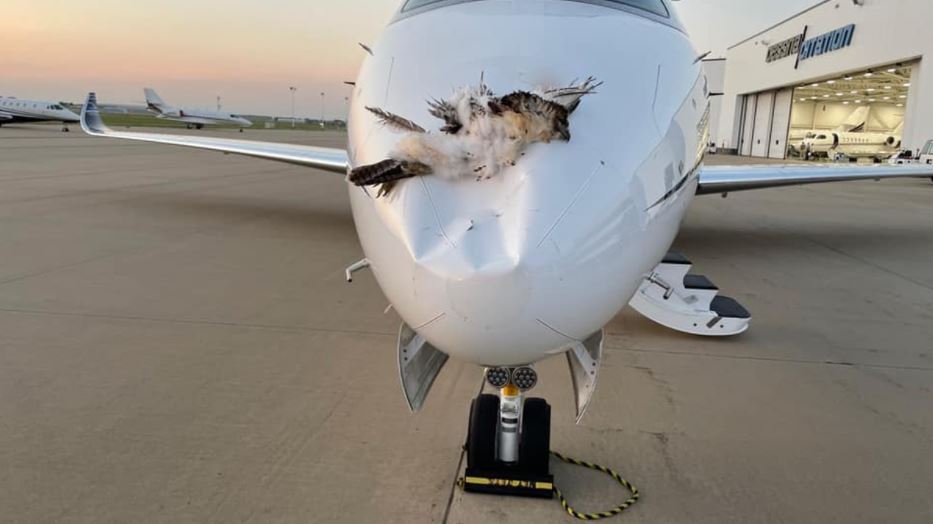
The white-colored aircraft enhance the visibility of the birds that can even be spotted from far-distant allowing the birds to identify the aircraft and steer away from it. Whereas the darker colors reduce the contrast between the aircraft and the visual background, reducing the birds’ ability to detect the aircraft, potentially increasing the risk of birdstrikes.
5. It is an economical choice
The aircraft paints can be pretty expensive. They are a special blend of polyurethane paints and various catalysts and activators to ensure their durability in harsh weather and the environment. Despite being way more expensive than the paints found in the market for interior or exterior decoration, the quantity required to paint the aircraft is quite considerable. The Boeing 737 involves an average of 260 liters of paint, whereas the Airbus A380 can require up to 3,600 liters of paint, so that the cost can be pretty high depending on the size of the aircraft.
And, as white is the most common color, the price of the color is also quite economical comparing to other darker and expensive shades. However, the economical reasoning is just a part; the thin layer of paint makes the aircraft less heavy, giving the aircraft extended fuel-efficient options.

